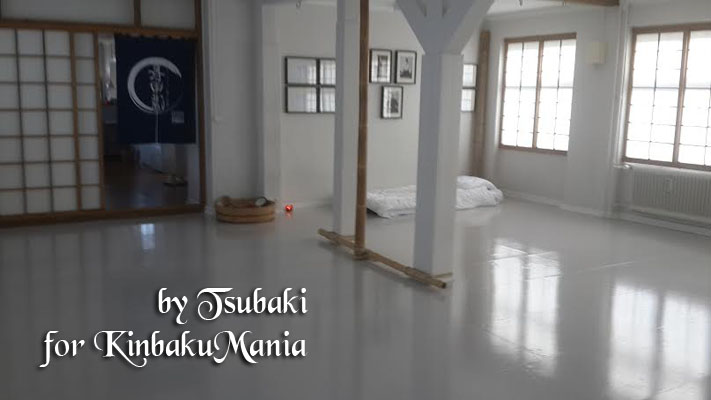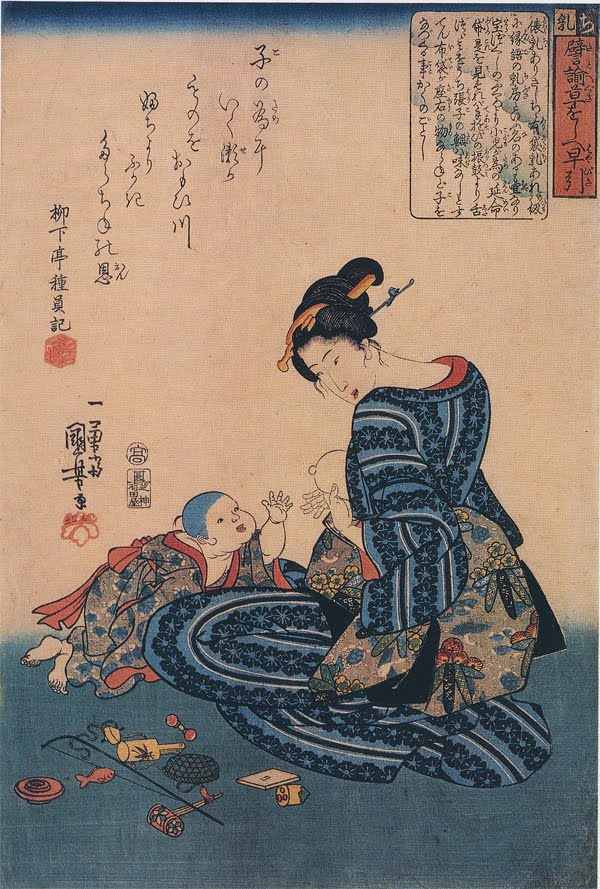As I was preparing to sleep over the tatami under my Senseis photos (Yukimura Haruki and Osada Steve) strategically placed in Yukinaga Max’s and Tina’s wonderful Copenhagen Shibari Dojo, I’ve noticed some beautiful Japanese Ukiyo-e drawings that immediately drown my attention.

These last years have been very intense for me in deepening my Kinbaku knowledge. As to enrich my vision I’ve included Japanese language classes as well as some investigation over some cultural artistic influences as Shodó and Ukiyo-e (a genre of woodblock prints and paintings) are. Before photography was even invented, long ago in the beginning of the 20th century, Ukiyo-e was the main method used for visual communication, both in news and politics as well as an artistic expression by itself. In the tradition of Ukiyo-e prints, there is a specific genre called “shunga” which literally means spring. Those prints, made by the best artists, generally remained unsigned. That happened even to Hokusai’s ones (who was one of the most talented artist).
These works I’m introducing next have drown my attention in several aspects. First one is from 1842 and it’s called “Mother and Child with Toys”. It was created by Kuniyoshi, who was Yoshitoshi’s mentor.
You can appreciate several things in this work. First of all, and probably the most important detail above all, you can see Takano Shinemon’s stamp in it. He was a censorship man of that time, and that fact confirms us that all prints needed to have the “approval” stamp in order to be able to be published in those days. That was not applied to “shunga” prints that were considered underground, and thus were much more expensive.
Secondly you can find this work interesting because it can be taken as a genuine example of what was called “abuna-e” (that was the name given to those images portraying “risk or danger” scenes). Trying to avoid censorship against pornography or erotic art sometimes the artist included some erotic or pornographic details to images that seemed to be completely naive, as a mother playing with her child would be. But what is highly remarkable in this case is that on the contrary to what we might expect the provoking part is not the exposed woman’s breast, but the long and sensual line of her exposed neck. This started to draw new lines on what is considered provocative or sensual from the Japanese cultural point of view. If I take this concept and apply it to my Kinbaku practices, there are many tying positions (as the “tasuki”) that can be used to stimulate that area. There are also some “gote” variations that can leave this area exposed, or even stimulate some areas close to the model’s neck, shoulders, or the upper part of her back.
This second work from Yoshitoshi was published in 1887 as an addendum to the Yamato newspaper. It is part of a series called “Live of Modern People”. The woman depicted in this print is Lady Muraoka from clan Konoe.
It’s evident for us that she’s tied up as the ropes around her arm and her neck are clearly visible. You can also see that the print suggest that the woman is enjoying the situation of being tied. Story behind this print is a bit different. “Muraoka” (1786-1873) supported the loyal faction opposing the new shogunate’s open door policy. It was on that time that happened the first opening of Japan to the rest of the world after three hundred years of self isolation. She was arrested and severely tortured during the Ansei’s purge in 1858. Her steel forged loyalty was highly renowned after shogunate’s fall. However this particular depiction that Yoshitoshi does of Muraoka may be interpreted as a sadomasochistic fantasy. Even when the woman is tied she shows herself seductive and her and oblivious of her predicament. He also depicts her very young if you keep in mind she was sixty something at that moment.(Shinichi Sege, Yoshitoshi: The Splendid Decadent).
This is other example of a very sensual print being allowed to be published. It may be because it’s author, Yoshitoshi, was considered a respected artist and so he was given some interpretation’s freedom. You may find it harsh to see an image of a sixty something woman being arrested and taken to be punished and tortured. That long strand of hair over her mouth is a typical Japanese erotic symbol. It reveals a deeper meaning and suggests a intimate bond between pain, ropes and eroticism as a cornerstone of modern Kinbaku.
On Master “K”’s notes about Yoshitoshi’s five prints where some shibari is shown you can see some very violent scenes of the series called “28 Famous Murders with Verse” (Eimei nijūhasshūku 英名 二十八 衆句).
The following are other of the renowned prints of Yoshitoshi. First one from 1885 is called “The Lonely House on Adachi Moor”, (“Oshu adachigahara hitotsuya no zu”).
Second one is from his 100 warriors selection: Saito Kuranosuke tied up in shibari and wound on his head.
I’m very interested to continue my investigations about Ukiyo-e prints, seme-e (torture prints) and the erotic Japanese arte story in general. Even when in occident we have the idea that Japan was more open minded and more permissive on erotic contents, we should start to realize that this historic concept was wrong. Shunga, ukiyo-e and seme-e works were subject to a strict and repressive censorship process both in the Meiji Era (1868-1912) as in the first years of the Showa period (1926-1945). It wasn’t until the enactment of the 21st Article of Japanese Constitution in 1947 after the Second World War that freedom of expression and free press concepts were taken into account.
While Occidental and Japanese culture differ on the perception of sexuality and nudity it’s probably unfair to state that Japan has a more lenient vision over erotic and pornographic art. Cultural, ideological and social conditions and manifestations may be different, but so are the reasons for censorship and banning.
Finally I wish to thank all my Masters that kindly and patiently enrich my knowledge every time.





